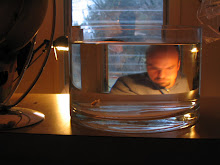So what's your favorite example of an artistic collaboration? The question quickly opens onto a field of tempting possible responses. Cage and Rauschenberg? Picasso, producing a Cubist drop curtain for Diaghilev's Ballets Russes? Rodgers and Hammerstein? Webber and Rice? Or do your tastes perhaps run a little more obscure? No worries: there are corresponding lists of lesser-known teams, as well.
Cleo and I don't appear on any of those lists, but in recent weeks we've been having fun exploring the possibilities of collaboration nonetheless. In fact, it's been a relative highlight of this extended winter: repeatedly, we've retired to a coffee shop, pulled out some paper, markers, and stickers, and gotten to work, riffing on the other's designs and trying to produce something that coheres and maintains an air of difference.
So it's not Exquisite Corpse, exactly, but we have managed to produce some relatively memorable, if not exquisite, monsters. The two-headed, lava-breathing, scaled specimen above is merely an opening exhibit, in this direction. At other times, though, the drawings develop in a more centrifugal manner, with a range of familiar motifs - crowns; Christmas trees - finding their place in a hectic environment of random objects and confrontations. Again, I don't want to force a parallel, but it seems to me that there's a vague echo of Basquiat's jazzy deployment of a private vocabulary in such images:
Ultimately, though, this drawing is most interesting to me for another reason: that is, in its function as a prompt. We drew it on a Saturday morning, before setting out for West Virginia. As we then drove, Cleo took up another sheet of paper and, without any access to the above image, produced a rough copy of it, from memory:
The sun, the spider, the plaintive dragon, and the ship, complete with rear window: they're all there, albeit in slightly modified form. But I see, too, an elegant emergent clarity, as the over-busy density of our teamwork gives way to a gentle, but hardly absolute, symmetry. Here, then, Cleo is not only author, but also viewer, and editor. Or, to put it differently, she extends the notion of collaboration so that it can encompass the active processes of memory and revision, as well.
Obviously, Cleo didn't invent that idea. Indeed, literary theorists have been arguing for more than a generation that that's how reading works. As Zadie Smith put it, a few years ago, "the problem with reads, the idea we're given of reading is that the model of a reader is the person watching a film, or watching television... And yet when you practice reading, and you work at a text, it can only give you what you put into it." Yes, that feels about right - and so, too, does Richard Rodgers' claim that "in many ways, a song-writing partnership is like a marriage. Apart from just liking one another, a lyricist and a composer should be able to spend long periods of time together - around the clock if need be - without getting on each other's nerves."
I'm no Rodgers; Cleo is no Hammerstein. But we do like each other, and we do spend long periods of time together. And one of the ways of passing that time, happily, is through the sort of collaboration that Rodgers and Hammerstein perfected.







No comments:
Post a Comment